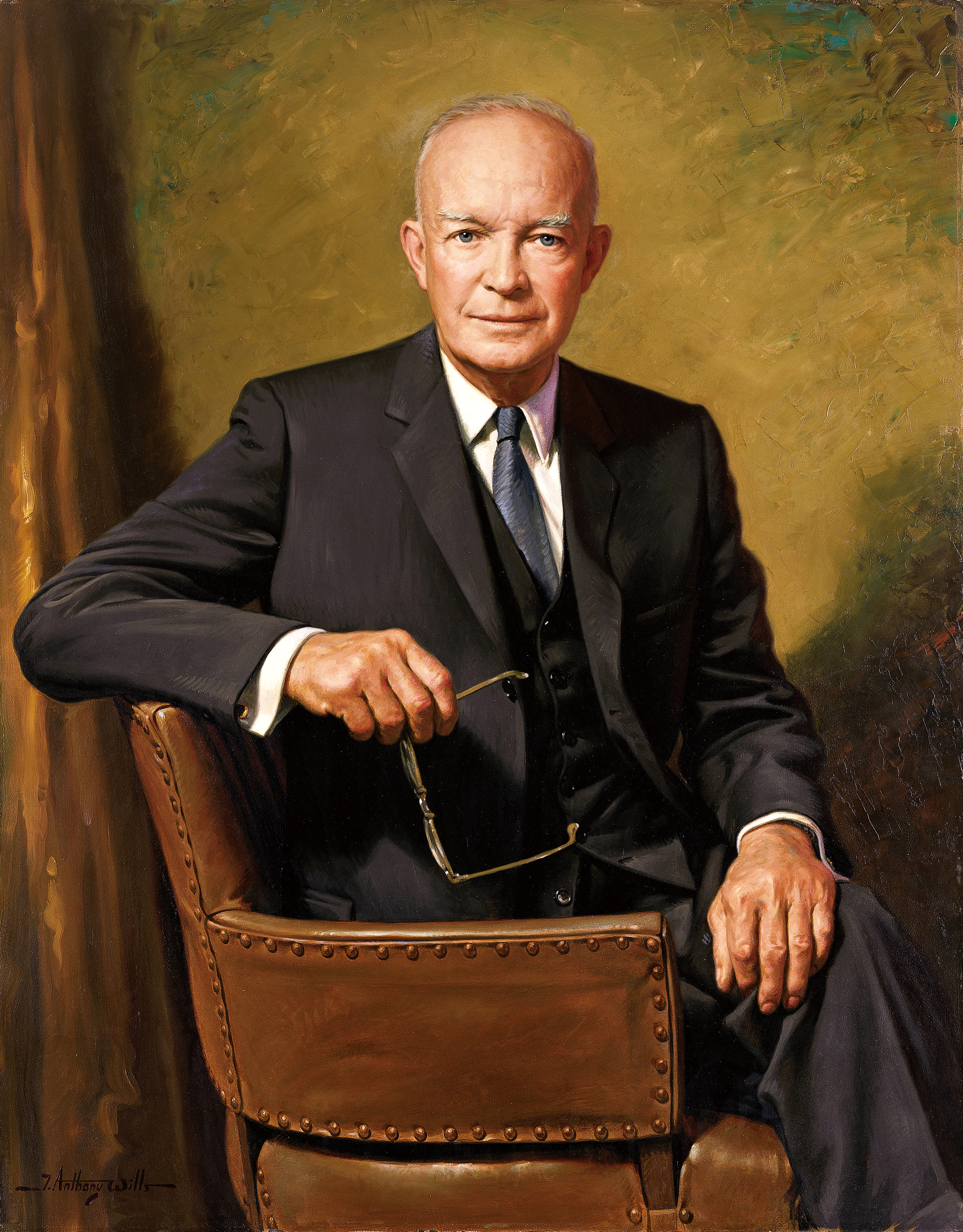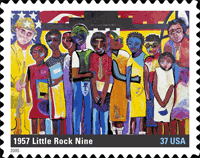

Topics on the Page
Harry S. Truman
-
Key Events and Speeches
- Truman's Order to Integrate the Military
-
Truman's Fair Deal
-
the Taft-Hartley Act (1947)
Dwight D. Eisenhower
-
Key Programs
- Interstate Highway System
- Eisenhower's response to the Soviet launching of Sputnik
- Farewell Address
-
Eisenhower's civil rights record
- The Civil Rights Act of 1957
For more, see AP United States History: The 1950s
Focus Question: What were the domestic policies of Presidents Truman and Eisenhower?
Harry S. Truman, 1945

Key Events and Speeches
Click here for the Truman Presidential Library
Harry S. Truman: Domestic Affairs
Here is a list of the Executive Orders President Truman signed, starting in 1945.
Truman's Order to Integrate the Military
President's Civil Rights Message on the Armed Forces, May 11, 1945.
President Truman, noticing the discrimination in the armed forces, decided to right that wrong in 1947 with an executive order that effectively desegregated the armed forces. This order which preceded the Civil Rights movement by more than a decade was the first step to abolishing segregation in American political and social institutions. This also made the Korean War (1950-1953) the first war were black and white soldiers fought in integrated units.
Click here to see a transcript of the executive order.
For background on the integration of the military, see Desegregation of the Armed Forces: Chronology from the Truman Presidential Library.
Truman's speech announcing the dropping of the the atomic bomb on Hiroshima, August 6th, 1945.
For more information on both President Truman and President Eisenhower's domestic policies and background information, please visit: http://www.whitehouse.gov/.
President Truman’s Fair Deal
-Expanded Social Security
-Developed a full-employment program
-Issued Executive Order 9980: Fair Employment Practices within the Federal Establishment
-Issued public housing and slum clearance legislation
Following in the footsteps FDR had taken when developing his New Deal Policies, Truman felt it was the government's job to intervene and fix things after WWII. His response was the Fair Deal, a 21-point program of proposed reforms.

- Domestic program that built off of FDR's “New Deal” plan.
- Harry Truman believed that the Federal government should guarantee certain rights to people, like economic opportunity and social stability.
- After WW2, Truman wanted to transition the country into a peacetime economy.
- With millions of soldiers returning home from war looking for jobs and homes there was a lot of unrest.
- The GI Bill was passed before the end of war, which helped returning soldiers buy houses with guaranteed loans for home-buying and financial aid for university education and industrial training.
- Labor unrest became a problem after the war, as the production ceased and many found themselves without jobs.
- In 1946, 4.6 MILLION people went on strike, More than ever before in U.S. history, demanding labor changes.
- While dealing with critical economic and social issues, Truman had a very broad approach, which brought on criticism from many, like the Republicans.
- Truman presented Congress with a 21-point program, Less than a week after the war ended which provided:
- protection against unfair employment practices
- a higher minimum wage
- greater unemployment reimbursement
- housing aid.
- However, this scattershot approach often left Truman's priorities unclear.
- Conservative legislators, who wanted to reduce the role of government, found Truman’s ideas to be a bad idea.
As shown in the political cartoon to the left, Truman was criticized for overreaching his presidential authority by his conservative Congress.
- Truman’s Fair Deal economic and social reform program helped him win the 1948 election, with the vote of farmers, workers, African Americans, over the dominating Republican party, in one of the biggest upset of American politics.
- The effects of Truman’s Fair Deal plan were mixed. Some improvements were made, like an increase in the minimum wage. However, Truman’s preoccupation with Cold War affairs held back his effectiveness.
 Read a transcript of Truman's Fair Deal speech, January 5, 1949
Read a transcript of Truman's Fair Deal speech, January 5, 1949
Click here to read a Washington Post article about the Fair Deal from 1949.
The Taft-Hartley Act (1947)
-
Also called the Labor Management Relations Act
Taft-Hartley Act
- Sponsored by U.S. Senator Robert A. Taft and Representative Fred A. Hartley.
- Amendment to The National Labor Relations Act
- Passed on June 23, 1947, after much resistance from labor leaders and a veto from President Truman who denounced it as a "slave-labor bill"
- The Act provided the following:
- Declares all closed shops, where only union members can be hired, illegal.
- Allows the president to appoint a board of investigators to explore union disputes when he believes a strike would endanger national security or health, and obtain an 80-day injunction to stop the continuation of a strike.
- Allows union shops only after a majority of workers vote for them.
- Prohibits unions from contributing to political campaigns.
- Forbids jurisdictional strikes and secondary boycotts.
- Limited the power of labor unions and required union leaders to affirm they were not supporters of the Communist Party, this action was upheld by the Supreme Court in May, 1950.
- Even though many people tried to repeal the act, it stayed in effect until 1959.
- The Taft-Hartley Act was a response to the mounting strikes occurring during the post-World War II labor surge. With millions of soldiers returning to the work force strikes became more common and it was a problem that Congress decided to address.
President Eisenhower's Key Programs
Dwight D. Eisenhower, Presidential Portrait

Click here for the Eisenhower Presidential Library
Dwight Eisenhower: Domestic Affairs
-Expanded Social Security.
-Launched largest U.S. public works projects in history, the Federal Highway Act of 1956.
-Established a permanent wartime economy in the midst of the Cold War.
Interstate Highway System
 |
| Annual vehicle miles traveled on the U.S. Interstate Highway System, 1957-2008 |

Ike's Interstates at 50, National Archives, 2006
10 Things You Might Not Know About the Interstate Highway System, Mental Floss (April 12, 2016)
Eisenhower's Farewell Address
Eisenhower's Farewell Address where he warns against the dangers of the military-industrial complex. Video segment from YouTube.
Eisenhower makes the point that this is the first time that the United States has a fully established weapons industry and this poses a threat to the liberty of the country. He also said the greatest danger that faces the nation is the threat to the national balance. He feels that if the nation gets thrown out of balance in all facets of society our nation will not endure.
Text of the speech from the National Archives.
Eisenhower’s Civil Rights Record
- During his first 3 years in office (1953-1955) he presented no civil rights legislation to Congress.
- Eisenhower believed that racial segregation could not easily be changed, even by U.S. Government legislation.
- In 1958, he asked Congress to pass the Equal Rights Amendment. While it would fail to pass, it became a lightning rod for feminism in the decades to follow and Eisenhower was the first president to support it.
- He was the first president to appoint an African American to an executive position on the White House staff, Frederic Morrow.
- He introduced the Civil Rights Act of 1957, aimed to guarantee that all African Americans could exercise their right to vote.
- It also was aimed toward a new division within the federal Justice Department to monitor civil rights abuses and a joint report to be done by representatives of both major political parties on the issue of race relations.
- His effort towards civil rights helped him gain support among black voters when he successfully ran for reelection to the presidency.
Eisenhower on women's rights and their role in government.
The Little Rock Nine

The Little Rock Nine
In an 1957 event known as the "Little Rock Nine," the Governor of Arkansas refused to integrate their public schools. President Eisenhower sent in a division of the military to ensure the safety of the nine black students who were to attend an all-white school. This action was done to uphold the ruling of the Brown v Topeka Board of Education Supreme Court Case.
The Little Rock Nine was highly controversial. Some believed that the South needed to take its time with adjusting to new racial policies.
Civil Rights activists in the US lauded the Supreme Court decision, comparing it here to breaking the chain of segregation.
 Address On the Situation in Little Rock was President Eisenhower's speech regarding the decision to send the 101st Airborne to enforce federal law dictated in the Supreme Court Case of Brown v. Topeka Board of Education.
Address On the Situation in Little Rock was President Eisenhower's speech regarding the decision to send the 101st Airborne to enforce federal law dictated in the Supreme Court Case of Brown v. Topeka Board of Education.

Video by History.com on the Little Rock Nine.

Little Rock Nine 50 years later
Little Rock Nine Congressional Gold Medal (1998)
 Daisy Bates Letter about the Little Rock Nine, December 17, 1957
Daisy Bates Letter about the Little Rock Nine, December 17, 1957
Online Documents from the Eisenhower Presidential Library
.png) First Day of Integration at Central High School
First Day of Integration at Central High School
 Sample Test Question (2007)
Sample Test Question (2007)
Which of the following was an effect of the Taft-Hartley Act (1947) on labor unions?
a) It prohibited labor unions from being segregated.
b) It restricted the organizing activities of labor unions.
c) It allowed labor unions to use dues for political activity.
d) It guaranteed health benefits for members of labor unions.
CORRECT ANSWER: B
Works Cited:
- http://www.britannica.com/eb/article-9070904/Taft-Hartley-Act
- http://www.hq.nasa.gov/office/pao/History/sputnik/
- http://www.whitehouse.gov/history/presidents/de34.html
- http://encarta.msn.com/encyclopedia_761564651/New_Deal.html#p7
- http://www.spartacus.schoolnet.co.uk/USAhartley.htm
- http://www.eisenhower.utexas.edu/dl/LittleRock/littlerockdocuments.html
Comments (0)
You don't have permission to comment on this page.